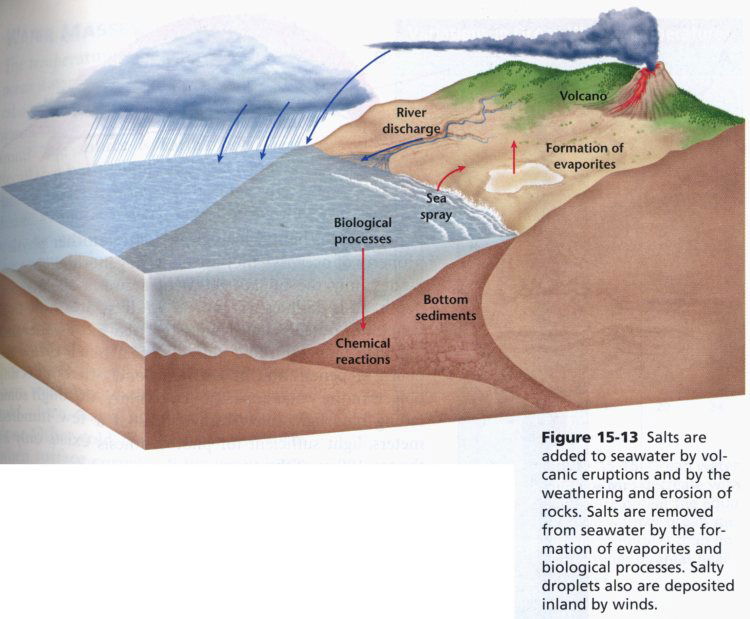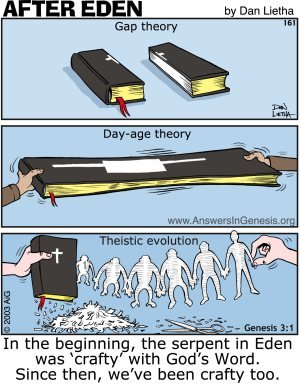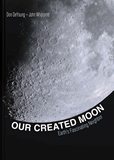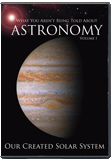
Chapter 5
Age of the Solar System
Many dating methods establish a maximum age for many earth and space systems that is much too small to confirm the evolutionary age of 4.5 billion years.
Then God said, “Let there be lights in the firmament of the heavens to divide the day from the night; and let them be for signs and seasons, and for days and years; and let them be for lights in the firmament of the heavens to give light on the earth”; and it was so. Then God made two great lights: the greater light to rule the day, and the lesser light to rule the night. He made the stars also.
—Genesis 1:14–16
What You Will Learn
Evolutionists and young earth creationists both agree that the earth is about the same age as the solar system. Evolutionists believe that both formed spontaneously about 4.5 billion years ago. Young-earth creationists believe that the earth was formed on Day One and the rest of the solar system and universe on Day Four. Ultimately, these two positions are based on foundational beliefs— man’s authority versus God’s authority. Evolutionary scientists start with man’s ideas about the age of the earth and build their theories around a set of starting assumptions. These assumptions are then used to interpret the data from the different dating techniques that can be used to estimate the ages of the earth. The most popular of these methods uses radioactive isotopes to calculate the age of rocks, but there are other methods that do not agree with the interpretation of radiometric data. These other methods are often ignored or explained away by evolutionists.
Young earth creationists point to dating techniques that put a limit on the age of the earth and solar system. These methods include the strength of the earth’s magnetic field, the amount of salt in the ocean, the history of human civilizations, and others to confirm the biblical models and show that the evolutionary models cannot be accurate. These methods establish a maximum age for many earth and space systems that is much too small to confirm the evolutionary age of 4.5 billion years.
From a biblical perspective, any dates that extend beyond 6,000 years must be rejected. When considering life on earth, including human cultures and artifacts, we must also consider the Flood of 4,300 years ago. Cave paintings made 15,000 years ago are presented as fact in the textbooks, but these dates cannot be accepted as truth according to the ultimate standard—the Bible.
What Your Textbook Says about the Age of the Solar System
| Evolutionary Concept | Prentice Hall | Glencoe | Holt | Articles |
|---|---|---|---|---|
| People used to believe the earth was 6,000 years old but science has shown it formed 4.6 billion years ago. | T1C, 2, T306C–D, 336–337, 347, 350 | 6, 385, 387, 557, T563, 570–571, T576, 578–579, T581, 581–582, 610, T662, 648, T686 | 27, 35, 185, 216–217 | 4:1, 4:3, 5:1, 5:2, 5:3, 5:4 |
| Human history goes back tens of thousands of years. | T354 | T384C, 385, T654, T654C, T678, 715 | 226, T406, T417D, T657D | 5:1, 5:2, 5:3, 5:4, 5:5, 5:6, 5:7 |
| Earth’s processes (magnetic field, climate, energy/matter, volcanic activity, continent formation, ocean salinity, precession, etc.) indicate that it is very old. | 20–21, 94, T156C, T278D, 287, 423, T586D, T600, 602, 657, 664–665 | 234, 359, 393–395, T395C, 471, 481, T490, 565, T654D, 657, 679, 686, T697, 740–741, T783, 783 | 36, 155, 173, T237D, T244, 244–245, 257, 259, 291, 338, T469D, 548, 740, T777 | 5:1, 9:1 |
Note: Page numbers preceded by “T” indicate items from the teacher notes found in the margins of the Teacher’s Edition.
What We Really Know about the Age of the Solar System
If you were to ask most people how we determine the age of the earth and the solar system you would probably hear something about radiometric dating of rocks. Although this is one way that evolutionary scientists interpret the age of the earth, there are many other techniques that can be used. Both evolutionists and biblical creationists would agree that the earth and the solar system are about the same age—the actual age of each is where they disagree.
Other methods can be used to date events in the history of the solar system. Using lunar recession, we established a limit of 1.5 billion years on the age of the moon (see chapter 3). This does not mean that the solar system is that old, but that it cannot be older than that. Since the biblical age of 6,000 years falls within that age and the evolutionary age of 4.5 billion years is well beyond that limit, this dating technique confirms the biblical model as a reasonable answer. The moon was created very near its present position and has moved away from the earth in the last 6,000 years.
Glencoe 395

Despite the evolutionists’ claim that the salinity of the ocean is constant, there is no physical mechanism to support the claim. Of the known inputs and outputs of salt only about 25% of sodium can be shown to leave the oceans. This limits the age of the oceans to 62 million years—a problem for evolutionists.
The amount of salt in the oceans is another way to set a limit on the age of the earth’s oceans. In the evolutionary model, the seas formed over 4 billion years ago. Salt has been accumulating in the oceans as salts flow into the oceans from rivers. Evolutionists claim that the sodium content is in a steady-state “because salts are removed from the ocean at the same rate as they are added” (Glencoe, p. 394). This is a false statement. Only about 25% of the sodium can be shown to be leaving the ocean. Knowing the rates of sodium input and output, the maximum age of the oceans can be calculated at 62 million years. Again, this does not fit within a billions-of-years explanation.
Within the biblical creation model, we can explain the relatively high concentration of sodium and other salts in the seas. If the earth were only 6,000 years old and we assumed that the change in salinity has been constant, the seas would contain much less salt than they do. However, we cannot forget that there was a global Flood about 4,300 years ago. As the Flood ripped up the surface of the earth, much mineral content would have been dissolved in the water that would eventually become today’s seas.
It is also impossible to know how salty the seas were at the time of their creation. More salt would have been transported to the seas as the water flowed off of the continents. Later, reservoirs (like the one that formed Grand Canyon) released their water and dissolved salts into the ocean basins. Starting with the history of the Bible, we can explain the present conditions of the oceans better than if we start from evolutionary assumptions and uniformitarian principles.
Other dating methods put a limit on the age of the earth and the solar system. Earth’s magnetic field is becoming weaker. Evolutionists have created a hypothesis to explain the cyclical nature of the direction of the earth’s magnetic field. This hypothesis has many problems and maintains that the field takes hundreds of thousands of years to reverse. The zebra-striped pattern of magnetism in the spreading sea floor is used as evidence that the ocean basins are many millions of years old. This will be discussed in more detail in chapter 9.
Evidence from lava flows has shown a rapid change of 45° in the magnetic field direction over a 15-day period. Creationists explain this as fluctuation during the catastrophic events of the Flood period, while evolutionists have great difficulty explaining such rapid changes.
Indicators of the youthfulness of the solar system, and therefore the earth, are the intricate rings of Saturn and Uranus, and the large amounts of heat given off by planets like Jupiter. The presence of comets and other evidences discussed in chapter 3 confirm the biblical teaching of a young earth and solar system.
The textbooks, as well as any other source of evolutionary content, use the word prehistoric when referring to events that allegedly occurred before recorded history. Fossils are often described as being from prehistoric times as is art found in caves and the development of agriculture. The idea of prehistoric men hunting prehistoric animals is not a biblically sound idea. As Genesis is a record of the earth and universe from “the beginning,” there could not have been anything that existed before the beginning—aside from God. So there could have been nothing before recorded history. Based on this argument, the term prehistoric is unbiblical. We may consider things to be ancient if they are thousands of years old, but there has never existed a time during which written records have not been kept.
When Adam was created on Day Six, he had the ability to communicate with God and Eve. The ability to name the many animals that he named demonstrates his intellect and command of language. With such intellect, why would we accept that he was not able to write as well? His grandsons are noted for their skills in metalworking and music, so it is natural to assume that they could record ideas in written form. Any records kept before the Flood would have been lost, except for those that Noah could have very easily preserved aboard the Ark. Though the earliest known written records come from the period shortly after the Flood, there is no biblical reason to doubt that these ancient men and women could read and write. We cannot rightly call events, peoples, and artifacts prehistoric because the highlights of human history are recorded from the beginning of time.
How, exactly, do we arrive at the dates that should be assigned to events that are both historic and allegedly prehistoric? The answer is to look to the Bible as the primary source of truth. Since the Bible is the inspired Word of God, we can trust its history. When we look at the Bible, we see that the earth is only about 6,000 years old—a claim that evolutionists must deny.

Although man’s ideas about the age of the earth continue to change, God’s Word remains a constant source of truth.
The 6,000-year age of the earth is quite simple to glean from the Bible, though there is no passage that says exactly how old the earth is. We know that there have been roughly 2,000 years between the present and the birth of Christ. There were approximately 2,000 years between Christ and Abraham, and then the Bible gives detailed genealogies from Abraham to Adam. Genesis 5 and 11 provide chronological genealogies that, through some simple addition, provide another 2,000 years between Adam and Abraham. Combining these three periods of human history, we arrive at the biblical age of approximately 6,000 years.
Knowing the biblical age of the earth, we can compare the dates given in the textbooks and other sources. Any dates beyond 6,000 years must be incorrect interpretations of the evidence. One example is the dating of cave art to 15,000 years ago. Since the caves were formed after the Flood, these drawings cannot be older than about 4,300 years. Likewise, any cultures or their artifacts cannot be older than the dispersion at Babel. This event happened after the Flood and before Abraham, or around 4,200 years ago. The inflated ages given to these ancient cultures are based on evolutionary and uniformitarian assumptions. These faulty assumptions lead to faulty dates.
Just as we cannot accept dates for events on earth that extend beyond 6,000 years, neither can we accept dates of billions of years for the formation of the earth and the solar system. Ultimately, the age of the earth and the solar system are based on beliefs. Believing that evolutionary science can answer the question leads many to an age of 4.5 billion years. Believing in the Bible as the source for truth leads to a radically different conclusion—an earth which is 6,000 years old.
Reference Article Summaries
5:1 Evidence for a young world
Humphreys, www.answersingenesis.org/docs/4005.asp
Fourteen natural phenomena are presented that demonstrate the young age of the earth. Many natural processes can be used to set a maximum age of the earth. This article explains each of the methods and the maximum age calculated—all of which show that the earth is too young to have formed 4.5 billion years ago.
The dating methods include the following: galaxies that wind themselves up too fast, too few supernova remnants, short-lived comets, too little sea floor mud, too little sodium in the sea, earth’s strong magnetic field, tightly bent strata, intact DNA in fossils, radiohalos, helium in minerals, carbon-14 in deep layers, too few Stone Age skeletons, the recent development of agriculture, and the short history of written records. These evidences, along with many others, support the biblical age of the earth—a young age of 6,000 years.
5:2 The world: born in 4004 BC?
Pierce, www.answersingenesis.org/articles/am/v1/n1/world-born-4004-bc
The age of the earth is a very contentious issue, and Christians are often mocked for believing the earth is only 6,000 years old. This age had been widely accepted by Christians, and Archbishop Ussher’s date of 4004 BC was a respectable attempt at formulating the biblical age of the earth’s creation. The date came into doubt when people began to trust secular dating methods over the Bible.
Ussher used the Bible as the basis for his calculations, supplementing his research with other historical records, but always giving the Bible supremacy. Ussher went so far as to suggest that Day One of Creation Week was on October 23, 4004 BC. This might seem like a stretch, but Ussher used sound reasoning to arrive at his date. Though we cannot know for sure that Ussher’s date is accurate, it is certainly a reasonable date based on a plain reading of Scripture. With roughly 2,000 years since Christ, about 2,000 years between Christ and Abraham, and just over 2,000 years between Adam and Abraham, the biblical record clearly points to a 6,000 year old earth.
5:3 Why shouldn’t Christians accept millions of years?
Mortenson, www.answersingenesis.org/articles/nab/why-christians-shouldnt-accept-millions
For the first 1,800 years of church history almost all Christians believed in an earth created in six literal days about 4,000 years before Christ and that it was devastated by a global Flood. About 200 years ago the idea of long ages was popularized, and many in the church started accepting the opinion of man over the Word of God. The new views include a gap in Genesis, reinterpreting the days to mean long ages (day-age view), a local rather than a global Flood, the framework hypothesis, God-directed theistic evolution, and progressive creationism.
Those holding to the traditional view are referred to as young–earth creationists as all of the other positions accept an earth much older than 6,000 years. Many suggest that promoting a young earth hinders the message of the gospel and causes division in the church. However, compromising the text of the Bible to accommodate man’s ideas is much more dangerous.

Biblical support for the days of creation being 24 hour days is abundant. The Hebrew word yom means a 24-hour day in the vast majority of its uses and clearly within the context of morning and evening indicates a normal day. Exodus 20:11 confirms this idea as the Sabbath rest commandment is tied to Creation week. The 6,000-year age is clear from the genealogies given in Genesis 5 and 11 and other chronological information in the Bible. Jesus’s own words from Mark 10:6 confirm that Adam and Eve were made at the “beginning of creation,” not billions of years later.
Noah’s Flood was clearly a global event accompanied by earthquakes, tsunamis, and volcanoes as the water covered all of the high hills and mountains. The layers of rock containing billions of fossils are a testimony to this catastrophe. Radiometric dating of the layers is generally used to discredit the evidence supporting a global Flood in recent history, but those dating methods involve many assumptions and are based on anti-biblical ideas.
One of the most important points to consider is that the Bible clearly teaches that death is the result of sin. Belief in millions of years requires the death of billions of animals and the presence of disease and suffering in animals before Adam had sinned. Would God call a world “very good” if it contained such things? This makes God a bumbling, cruel creator who uses disease, natural disasters, and extinctions to advance life on earth while still calling it “very good.”
The biblical record makes it clear that the idea of millions and billions of years of earth history is not compatible with Christianity.
5:4 Meeting the ancestors
Grigg
It is interesting to think that Lamech, Noah’s father, could have talked with Adam about life in the Garden of Eden and that Abraham could have talked with Shem about life on the Ark. This is possible because the Bible meticulously records the ages of these patriarchs and their ages when their sons were born. By simple arithmetic, we can arrive at the age of the earth based on these genealogies. The specific dates given with each of these men make it impossible to insert large gaps in the history of Genesis.

These dates also allow us to accurately date the Flood at 1,656 years after God created the earth. It is often claimed by skeptics of a young earth that there are gaps or inaccuracies in the records. However, the details given, and the fact that the genealogies are repeated in 1 Chronicles and Luke 3, indicate these are precise, literal records. In the book of Jude we also read that Enoch was the seventh from Adam, just as we see in the Genesis 5 record. These ideas all reinforce that the genealogies give a record we can trust as an accurate, literal history.
5:5 Egypt or Babel: which came first?
Wise, www.answersingenesis.org/articles/am/v3/n2/egypt-or-babel
Many nations and cultures throughout history have claimed that they are the oldest nation. Historians have constructed chronologies to prove their claims, but the dates ultimately point to one pivotal event—the elusive date of the division at Babel. From the Bible, we can determine that the events of Babel happened between the Flood and the call of Abraham, but the exact date is unknown.
The nations were likely divided during the lifetime of Peleg (Genesis 10:25), who was born 101 years after the Flood and died 239 years after the Flood. This biblical time frame does not fit with the king lists of the Egyptians and Sumerians. However, these lists include kings who supposedly lived for thousands of years and overlapping ruling periods are listed as sequential. There are also different lists using different numbers of kings. The result is inflated genealogies when compared to the Bible.
Records of astronomical events also demonstrate that the non-biblical lists are inflated. Our current understanding of celestial movements allows us to determine when these events occurred, and it is clear that the record keepers extended their chronologies. This was most likely done to promote their culture and leaders over others. These records also fail to mention the division of languages. This would suggest that they were written after that event and that the record found in the Bible is the most reliable for dating Babel.
5:6 The sixteen grandsons of Noah
Hunt and Grigg
After the Flood, the earth was repopulated by Noah’s three sons, who had a total of sixteen sons of their own as recorded in Genesis 10. After the dispersion at Babel, these grandsons were spread across the globe and founded nations in the areas they settled.
Many ancient cultures worshipped their ancestors, and the names of many regions, physical features, and people groups can be traced back to one of the sixteen grandsons. Of the seven sons of Japheth, the Gomerites can be traced to Western Europe. The Welsh language is called Gomeraeg, and Welsh history records the landing of the descendants of Gomer 300 years after the Flood. Many other names can be traced through history back to one of these seven sons and their descendants as they settled throughout Europe and western Asia.
Of the four sons of Ham, Phut is the Hebrew name for Libya, Cush is the name for Ethiopia, and Mizraim the word for Egypt. The fourth son, Canaan, is the namesake of the region known as Palestine today—the biblical land of the Canaanites and Philistines.
From the five sons of Shem we can also identify where their descendants settled. Elam is the ancient name for Persia, the area we know as Iran today. Asshur is the Hebrew word for the Assyrians, and history records that he was worshipped by his descendants. Eber, a descendant of Arphaxad, gave his name to the Hebrew people, while Lydia, now western Turkey, bears the ancestry of Lud. Aramaic is the language of the Syrians, a group that can be traced to Aram.
Looking only briefly at the grandsons of Noah makes it clear that these were historical individuals who founded the earliest civilizations after the Flood.
5:7 Taking a bead on an old earth
www.answersingenesis.org/articles/am/v3/n1/taking-a-bead
A dozen seashell necklaces (or perhaps bracelets) were discovered in a cave in Morocco, North Africa. The discovery surprised archaeologists who dated the ornamental jewelry at 82,000 years old, but previously believed that humans had not developed such art until around 50,000 years ago.
Dating such discoveries has led some Christians to wonder when God created humans. Many “progressive creationists” have gradually pushed their range of dates back: 10,000–25,000 years, then 10,000–35,000, up to 60,000, and sometimes up to 100,000 years.
A clear reading of Genesis, on the other hand, shows that mankind was created about 6,000 years ago, but all vestiges of the earliest cultures were destroyed during the Flood. These artifacts, found in post-Flood geologic formations, must be less than 4,300 years old. The dating methods of secular archaeologists are based on incorrect assumptions, and the key to correct dates is the infallible Word of God.
Questions to Consider
- How many different ways are there to calculate the age of the earth and its systems? Why don’t they all agree? How do we know which is correct?
- How can we explain the relatively sudden appearance of advanced civilizations about 10,000 years ago if humans have been around for 100–200,000 years?
- Why do scientists reject the Bible as an accurate record of the past, when there are so many archaeological finds confirmed by the Bible?
- If the scientific age of the earth has changed many times in the past, why should we trust the dates given in the textbooks today? How old were you taught the earth was when you were in high school/college
Tools for Digging Deeper
The New Answers Book by Ken Ham et al.
The New Answers Book 2 by Ken Ham et al.
Radioisotopes and the Age of the Earth Volume 1 (Technical) by ICR
Radioisotopes and the Age of the Earth Volume 2 (Technical) by ICR
Thousands . . . Not Billions by Don DeYoung
www.answersingenesis.org/go/dating
www.answersingenesis.org/go/young
www.answersingenesis.org/go/anthropology
Evolution Exposed: Earth Science
Learn how to respectfully counter the evolutionary bias and indoctrination in astronomical and geological evolution.
Read Online Buy BookRecommended Resources

Answers in Genesis is an apologetics ministry, dedicated to helping Christians defend their faith and proclaim the good news of Jesus Christ.
- Customer Service 800.778.3390
- © 2024 Answers in Genesis





